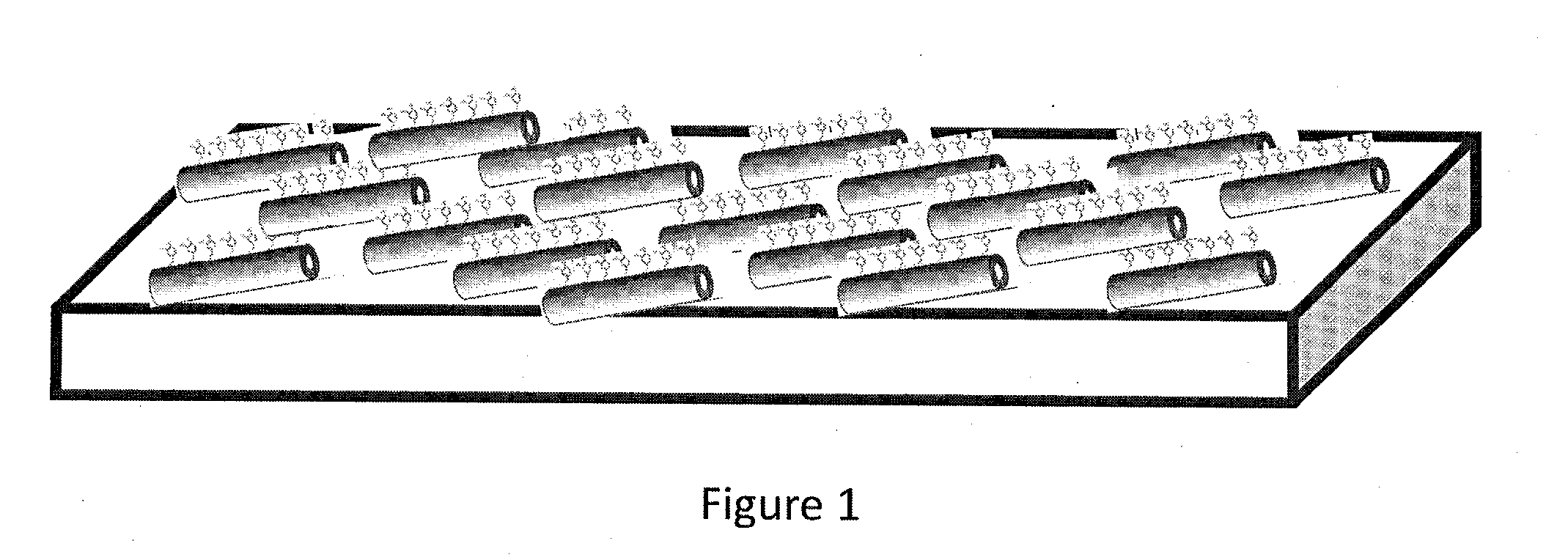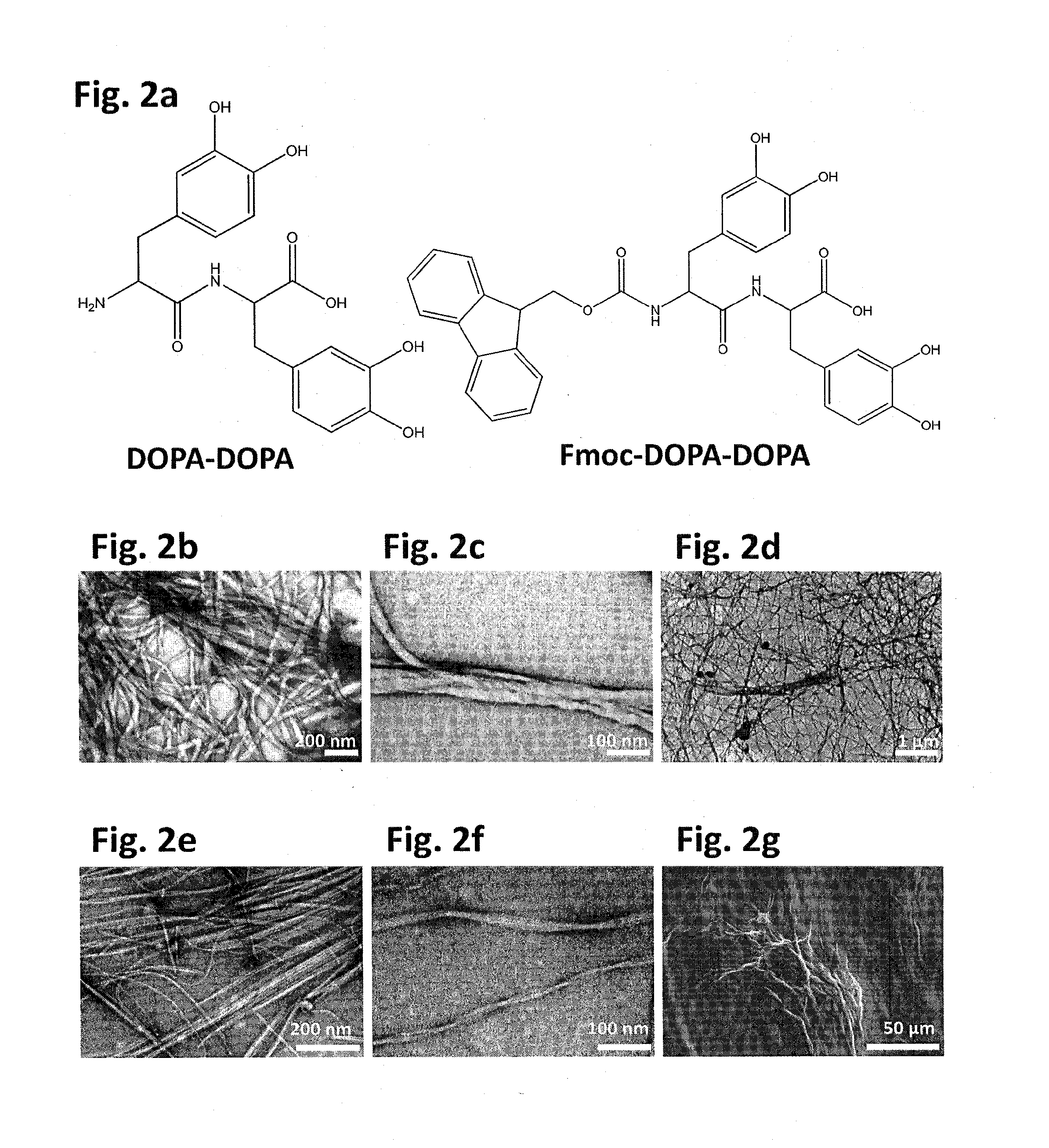Self-assembled micro-and nanostructures
a micro-and nanostructure, self-assembling technology, applied in the direction of natural mineral layered products, drug compositions, peptides, etc., can solve the problems of low bond strength, toxic to living tissues, and associated risk of viral or prion contamination, and achieve antibacterial anti-fouling, superior adhesive and/or anti-oxidant properties
- Summary
- Abstract
- Description
- Claims
- Application Information
AI Technical Summary
Benefits of technology
Problems solved by technology
Method used
Image
Examples
example 1
[0165]Nanostructures Self-Assembly
[0166]Material—Peptides (Fmoc-DOPA-DOPA, DOPA-DOPA, DOPA-Phe-Phe, Fmoc-DOPA-DOPA-Lys) were purchased from Peptron. Fmoc-DOPA was purchased from Ana Spec. A stock solution of Fmoc-DOPA was prepared by dissolving the building block with ethanol to a final concentration of 100 mg / ml. The stock solution was then diluted into water to the desired concentration (0.5 mg / ml, 0.75 mg / ml, 1 mg / ml, or 2 mg / ml). DOPA-Phe-Phe was prepared by dissolving lyophilized form of the peptide in 1,1,1,3,3,3,-hexafluoro-2-propanol (HFIP), at a concentration of 100 mg / ml or 50 mg / ml. The stock solution was either directly deposited on a cover slip glass slides or diluted into water to a final concentration of 2 mg / ml or 5 mg / ml.
[0167]For the formation of the DOPA-DOPA dipeptide asssemblies (FIG. 2A-left panel), lyophilized peptide was dissolved in ethanol to a concentration of 33 mg / mL then diluted with Milli-Q water to a final concentration of 5 mg / mL....
embodiment 1
[0177]Atomic Force Microscopy (AFM) was used to assess the adhesion of the formed structures to a silicon oxide tip by employing “force / distance” measurements. This type of measurements allows deducing the attractive forces between the AFM tip and the contacted surface, when this force is represented by the minimum value of a force / distance curve. For AFM analysis, 10 μl aliquot of the peptide suspension was deposited on clean glass slide and dried at room temperature. Force / distance curves were determined at several points using NanoWizardIII of JPK instruments AG.
Adhesion Measurements
embodiment 2
[0178]In an alternative embodiment, AFM analysis was performed using an Asylum MFP-1D AFM instrument (Asylum Research, Santa Barbara, Calif., USA). To obtain force data the different peptides were prepared in ethanol: Fmoc-DOPA (1%) Fmoc-DOPA-DOPA (5%), Fmoc-DOPA-DOPA-Lys (12.5 mg / mL), samples were prepared in either DMSO or ethanol (12.5%) these results were compared to measurements performed on bare glass slide.
[0179]The AFM measurment was performed by emploting force mapping while simultaneously providing nanoscale topographical and mechanical information about the hydrogel. Force mapping involves generating individual force curves at discrete points on a material, which are then used to calculate stiffness and height values.
[0180]After overnight incubation, 10 μL of each sample were deposited on a glass slide and dried at room temperature. Force measurements of the samples were conducted using a SiO2 colloidal probe (tip velocity 1000 nm / s, compressive force 20 nN). To investiga...
PUM
| Property | Measurement | Unit |
|---|---|---|
| diameter | aaaaa | aaaaa |
| diameter | aaaaa | aaaaa |
| storage modulus G1 | aaaaa | aaaaa |
Abstract
Description
Claims
Application Information
 Login to View More
Login to View More - R&D
- Intellectual Property
- Life Sciences
- Materials
- Tech Scout
- Unparalleled Data Quality
- Higher Quality Content
- 60% Fewer Hallucinations
Browse by: Latest US Patents, China's latest patents, Technical Efficacy Thesaurus, Application Domain, Technology Topic, Popular Technical Reports.
© 2025 PatSnap. All rights reserved.Legal|Privacy policy|Modern Slavery Act Transparency Statement|Sitemap|About US| Contact US: help@patsnap.com



